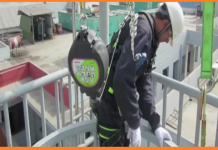
Contents
FULL BODY SAFETY HARNESS INSTRUCTIONS FOR USER
The full body harness is classed as a personal protective equipment (PPE) by the European PPE Directive 89/686/EEC and has been shown to comply with this directive through the harmonized European standard EN 361:2002
Carefully read these instructions before using the harness.
The harness is designed to minimize the risk of/provide protection against the danger of falling from heights. However, PPE cannot provide full protection and care must always be taken while carrying out the risky job.
Performance and limitations of use
The harness must be tested in accordance with EN:361:2002 and has achieved the following performance levels:
AN 361:2002 RESULT/COMMENT
Clause 4.1 Design and ergonomic- considered to be sufficiently light and likely to remain in place during use without becoming incorrectly adjusted without the wearer’s knowledge. (PASS)
clause 4.1 Material -Material type specified on the label as polyester- applicable of naked flame to webbing and thread resulted in melting consistent with synthetic material.
Different color webbing used for differentiating shoulders and leg straps, stitched with white thread. (PASS).
Straps present in pelvic and shoulder areas. (PASS).
Primary straps: 44 mm secondary straps: 44mm. (PASS).
The breaking tenacity of webbing and yarns, the requirements is at least 0.6 N/tex.(PASS)
Limitations of Safety Harness/Belt
- The harness should be the personal property of its user.
- The strength of the anchor device should conform according to AN 795/1996 OR min. 10kN.
- The full body harness should be used in any case where there is a danger of free fall.
- It should not be used in highly acid or basic environment.
- Protect the harness from mechanical hazards like sharp edges, tools, exposure to sunlight, ultraviolet radiation both during usage, transportation, and storage.
- If the harness has an extension hand at the back D-Ring, make sure that the total length of the lanyard+ energy absorber + connectors + extension hand is not more than 2.0ms. The user must read the instructions for the energy absorber and understand clearance requirements.
FITTING & SIZING OF FULL BODY SAFETY HARNESS:
Follow step 1 to step 6 to wear the harness. Both leg straps, as well as shoulder straps, are adjustable to fit the size of the user. A harness either too loose or too tight will restrict movement and will not provide the optimum level of protection. The size of the harness is marked on a label attached to it and it is universal.
Visually inspect the harness before use to ensure that it is in a serviceable condition and operates correctly.
Step 1: hold the harness by the dorsal D-Ring as shown in figure 1, marked as ‘A’ on a label. Use this as an attachment element for connectors, lanyards, energy absorber, etc.
Step 2: insert your arms into the shoulder straps (left arm into the left shoulder straps, right arm into right shoulder strap) and close the metallic buckles on the chest strap as shown in figure 2, marked as A or A/2 on the level.
Step 3: the harness is now on the body with two leg straps hanging down at the back. Pull the leg straps one by one around your thighs outwards to your fronts.
Step 4: close the adjustable buckles of the leg strap one by one.
Step 5: tighten the leg straps by pulling the free ends of the straps as shown in figure 6 until the harness fits the body tightly without hindering free movements.
Step 6: now depending upon the condition of usage, use the front textile loops or the dorsal metallic D-Ring or both as the point of attachment of fall arrest systems.

In case of any doubt arising about the condition of any component or system, replace it immediately. If the item has arrested a fall, withdraw it from service & return to the manufacturer or to a competent repair center.
While using the harness, ensure that there is a minimum clearance of 5ms. Below the user’s feet, to avoid him hitting the ground in case of fall.
Apart from fall arrest, this harness can be used in specific situations in conjunction with fall arrestor where a front attachment is needed.
A rescue plan has to be set up before Use, for carrying out a rescue operation in case of emergency.
Material used in Safety Harness/Belt
The entire webbing will use in the harness which made up of polyamide and breaking tenacity of webbing and yarns must have at least 0.6N/tex.
Warning
Ensure that the User instructions are complied with for all another component in the fall arrest systems like lanyards, karabiners, etc.
Compatibility
To optimize protection, in some instance it may be necessary to use the harness with suitable boots/gloves/helmet/ ear defenders. In this case, consult with the supplier to ensure your protective product are suitable and compatible for risky activities. Also, ensure that the product is used by a trained and OR competent person.
Storage and transport of Safety Harness/Belt
When not in use, store the harness in a well-ventilated area away from extremes of temperature. Never place heavy items on top of it. As for as possible, do not excess fold and store it hanging vertically. If the product is wet, allow it to dry fully before placing it into storage.
Repair of Safety Harness/Belt
If your PPE is damage, it will not be able to protect you properly. Therefore, if any problem found in PPE, then it should be immediately removed from the work and send to repair or replace. Never use the damaged product. Only Repairing by the manufacturer or competent repair center.
Cleaning of Safety Harness/Belt
In case of minor soiling, wipe the full body harness with the cotton cloth or a soft brush. Do not use any abrasive material. For intensive cleaning wash the harness in water at a temperature between 30°C to 60°C by using a neutral detergent (pH±7). The washing temperature should not exceed 60°C. Do not use acid or basic detergent. Follow the washing instructions absolutely without any deviations.
Lifespan of Safety Harness/Belt
The lanyard life is determined by work conditions and maintenance. If the product passes inspection criteria it may remain in service. It can be used up to one year if suitable maintained.
Checkpoints before use at site:
The harness is marked with:
- The CE Mark showing that the product meets the requirements of the PPE directive 89686/EEC.
- Identification of the manufacturer
- Type of product code
- Serial no. Of the harness
- Materials
- Size
- Month/ year of manufacture
- Number and year of the document to which the equipment conforms
- Pictograph to indicate the necessity to read the instructions of use.
- Denotes anchors points.
- Denotes one half of an anchorage.
Also read this:
The capacity of safety harness





You are very genious brother.
I appreciate You heart and soul.
May God bless you.
Thnx
Thanx